Thalinomics is the economics of a plate of food in India.
- It is an attempt to quantify what a common person pays for a Thali across India. Has a Thali become more or less affordable? Has the price of a Thali increased or decreased?
- Is the inflation the same for a vegetarian Thali as for a non-vegetarian?
- Is the inflation in the price of a Thali different across different states and regions in India?
- Which components account for the changes in the price of a Thali – the cereals, vegetables, pulses or the cost of fuel required for its preparation?
- The evolution of prices of vegetarian and non-vegetarian thalis during the period from 2006-07 to October 2019-20 is analysed.
- Prices data from the Consumer Price Index for Industrial Workers for around 80 centres in 25 States/UTs from April 2006 to October 2019 have been used for the analysis.
Major Findings
- Both across India and the four regions– North, South, East, and West –it was found that the absolute prices of a vegetarian Thali have decreased since 2015-16 though it increased during 2019.
- This is due to significant moderation in the prices of vegetables and dal from 2015-16 when compared to the previous trend of increasing prices.
- In fact, the increase in prices of both components has contributed to the increase in the Thali price during 2019-20 (April – October) as well.
- It was found that the affordability of vegetarian Thalis has improved over the time period from 2006-07 to 2019-20 by 29% and that for non-vegetarian Thalis by 18%.
Thali Prices
- In 2015-2016, due to many reform measures that were introduced during the period of analysis to enhance the productivity of the agricultural sector as well as efficiency and effectiveness of agricultural markets for better and more transparent price discovery, there was a slowdown in the prices of Thalis at the All-India level.
- Affordability of Thalis
- It is important to see how have the earnings of the individual changed during the same period of time compared to the prices of a Thali.
- In order to do this, we need to look at what share of his/her daily wages does a worker require to acquire two Thalis a day for his/her household members.
- It was observed that the affordability of Thalis has increased over the years.
- In terms of vegetarian Thali, it is found that an individual who would have spent around 70% of his/her daily wage on two Thalis for a household of five in 2006- 07 is able to afford the same number of Thalis from around 50% of his daily wage in 2019-20 (April to October).
- Similarly, the affordability of non-vegetarian Thalis has also increased with the share of wages required decreasing from around 93% to around 79% between 2006-07 and 2019-20 (April to October).
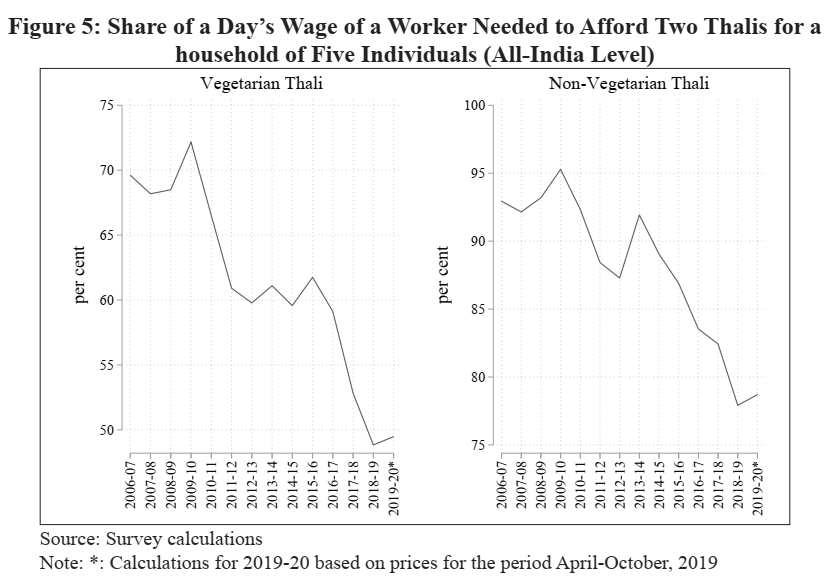
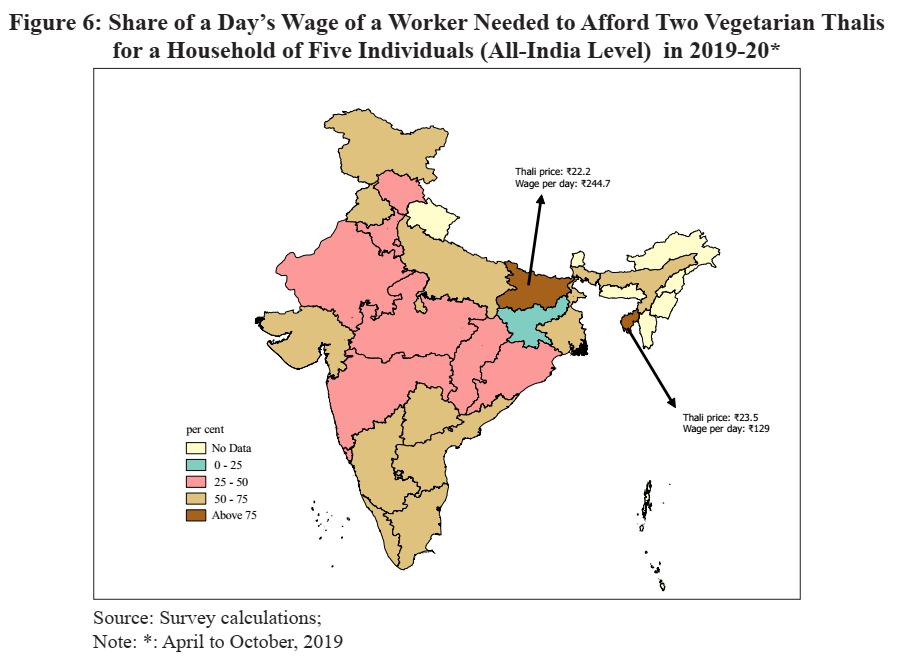
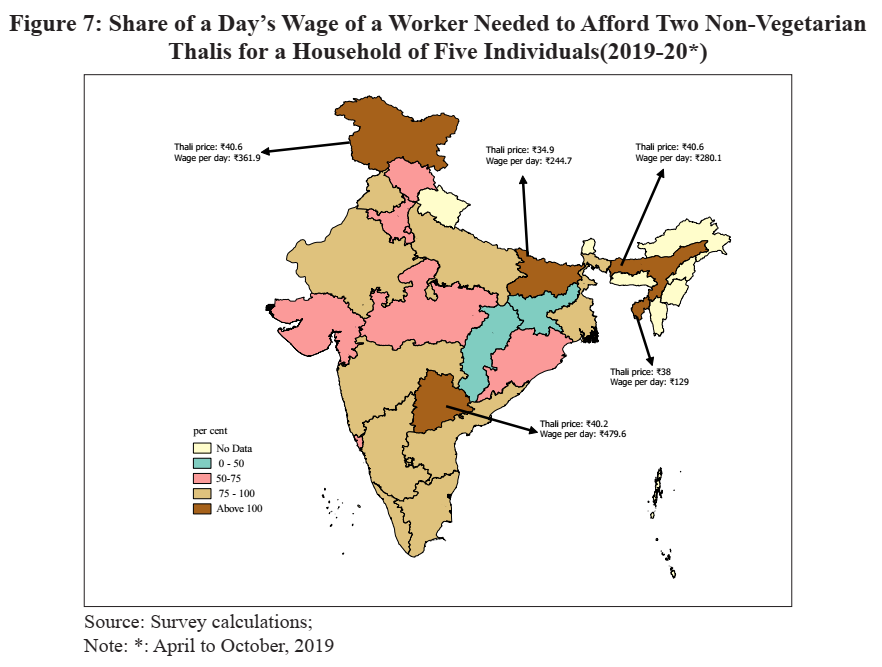
- Thali Inflation
- Thali inflation (year-on-year growth in Thali prices), which remained elevated during the initial part of the period of our analysis, has shown a significant reduction.
- An increase in the rate of inflation in vegetarian and non-vegetarian Thalis during 2019-20 is a temporary phenomenon that should revert back as has happened in earlier years.
- It is observed that inflation has been declining over time in all components. While inflation in cereals has been declining at a steady rate throughout the period, the fall in inflation has accelerated in all other components except Sabzi.
- Across regions and States, a similar trend is seen in inflation with overall Thali inflation showing a downward trend.
- Over the last year, the rate of inflation for Dal, Sabzi and non-vegetarian components has increased.
- Gains Region-wise
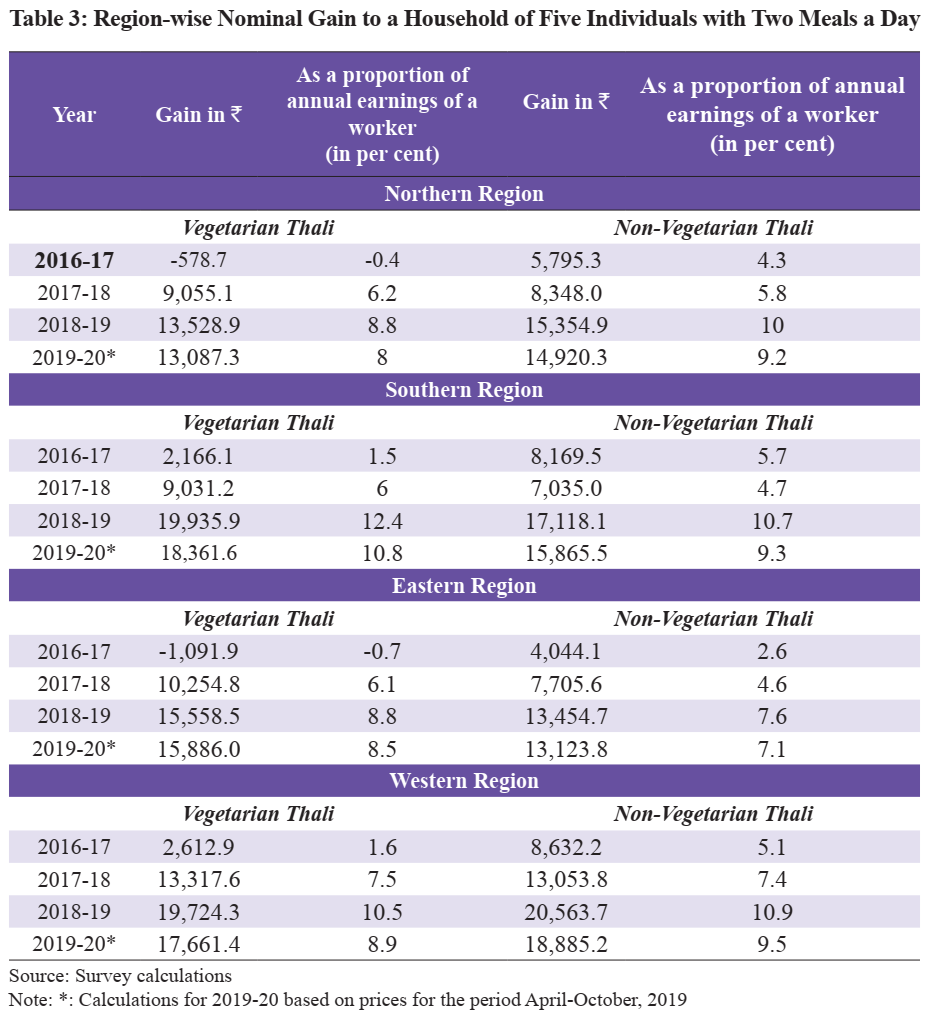
- Variability of Thali Prices
- It is seen that over the years, there is no specific trend in the variability of Thali prices at the All-India level across months over the years
- Similarly, in cases of variability across regions and across states, over time, there are no specific trends in the variability patterns.
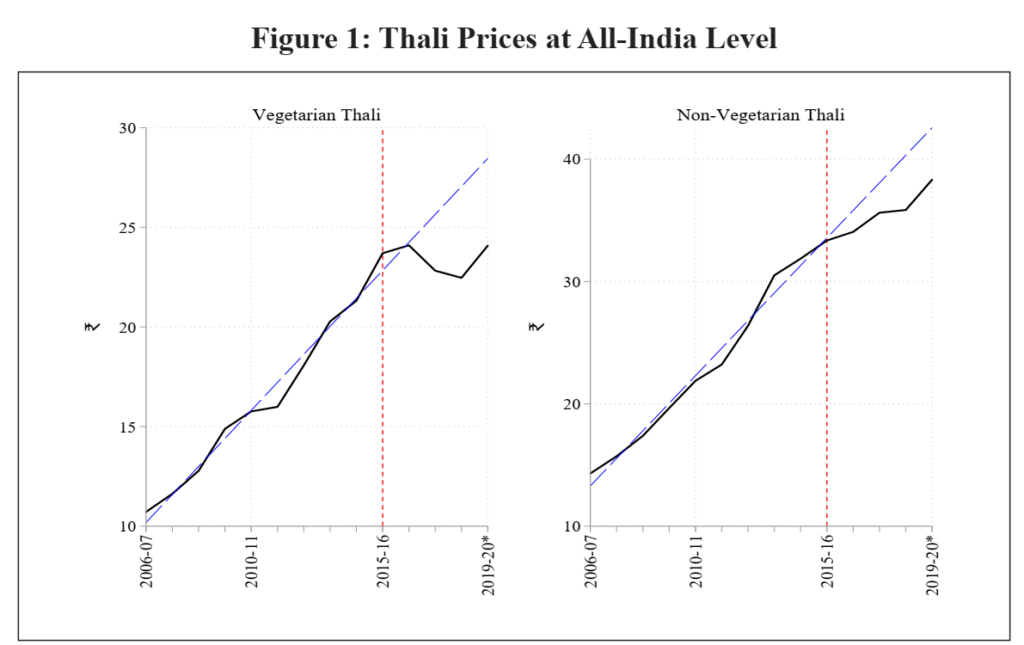
Some Major Initiatives for Enhancing Productivity of Agriculture and Efficiency of Agricultural Markets
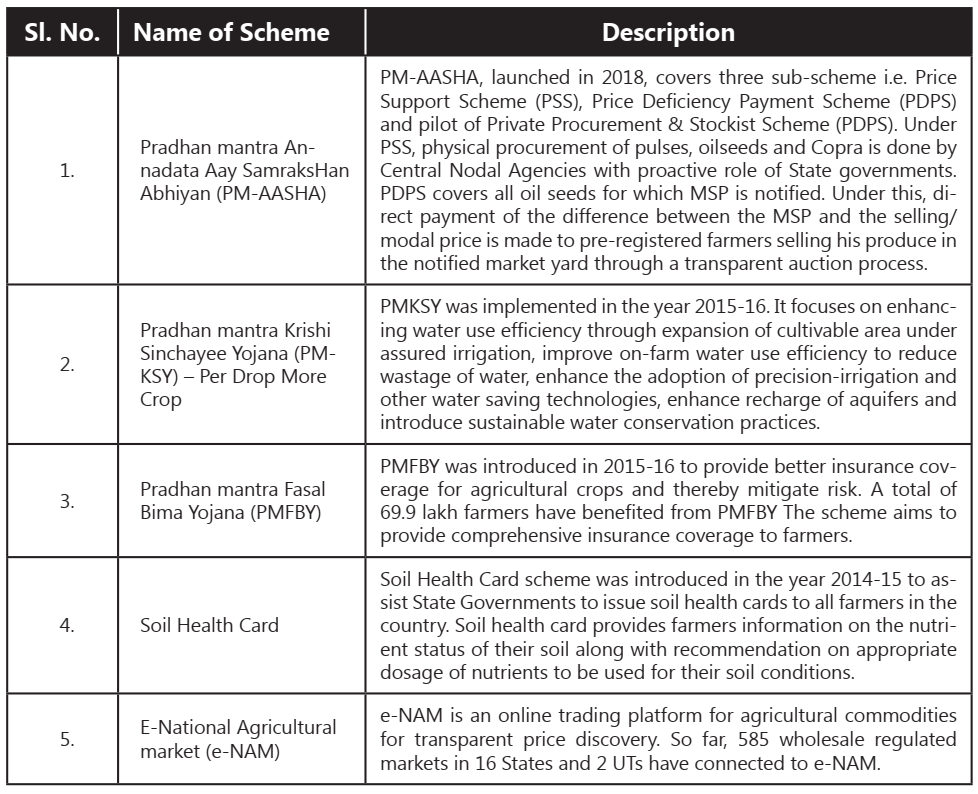
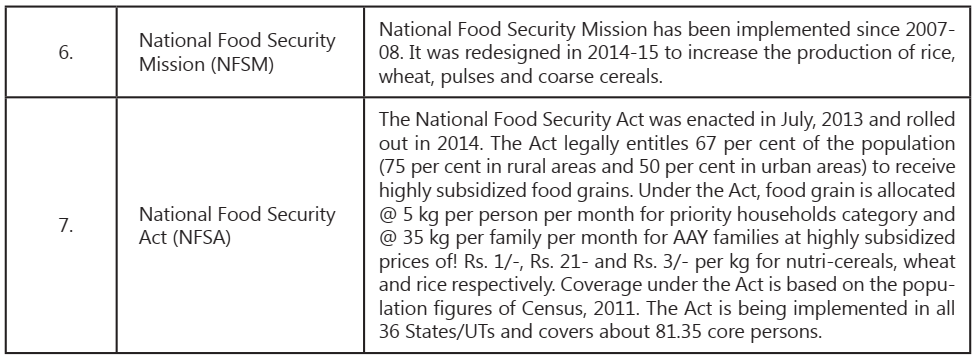
Conclusion
- Food is not just an end in itself but also an essential ingredient in the growth of human capital and therefore important for national wealth creation. ‘Zero Hunger’ has been agreed upon by nations of the world as a Sustainable Development Goal (SDG).
- This goal (SDG 2) is directly related to other SDGs such as Goal 1 (No poverty), Goal 4 (Quality Education), Goal 5 (Gender equality), Goal 12 (Responsible consumption and production), Goal 13 (Climate Action) and Goal 15 (Life on Land).
MCQs
- With reference to the food price inflation in India, consider the following statements:
1. The absolute prices of a vegetarian Thali have decreased significantly since 2015-16 though the price has increased in 2019.
2. In 2019-20, the most affordable vegetarian, as well as non-vegetarian thali, was in Jharkhand.
Which of the above statements is/are correct?
A. 1 only
B. 2 only
C. Both 1 and 2
D. Neither 1 nor 2
Ans. (C) Both across India and the four regions – North, South, East and West – it is found that the absolute prices of a vegetarian Thali have decreased significantly since 2015-16 though the price has increased in 2019.
As a result, an average household of five individuals that eat two vegetarian Thalis a day gained around `10887 on average per year while a non-vegetarian household gained `11787, on average, per year. Using the annual earnings of an average industrial worker, it is found that affordability of vegetarian Thalis improved 29 per cent from 2006-07 to 2019-20 while that for nonvegetarian Thalis improved by 18 per cent.
In 2019-20 (April-October, 2019), the most affordable Thali was in Jharkhand; two vegetarian Thalis for a household of five in Jharkhand required about 25 per cent of a worker’s daily wage. Non-vegetarian Thali was also most affordable in Jharkhand. - Consider the following statements about the ” Pradhan Mantri Annadata Aay Sanrakshan Abhiyan (PM-AASHA)”:
1. It is aimed towards ensuring remunerative prices to farmers for their produce.
2. Under Price Support Scheme(PSS), physical procurement of pulses, oilseeds and Copra is done by Central Nodal Agencies with the proactive role of State governments.
Which of the above statements is/are correct?
A. 1 only
B. 2 only
C. Both 1 and 2
D. Neither 1 nor 2
Ans. (C) The ” Pradhan Mantri Annadata Aay Sanrakshan Abhiyan (PM-AASHA, launched in 2018, covers three sub-scheme i.e. Price Support Scheme (PSS), Price Deficiency Payment Scheme (PDPS) and Pilot of Private Procurement & Stockist Scheme (PDPS).
Under PSS, physical procurement of pulses, oilseeds and Copra is done by Central Nodal Agencies with the proactive role of State governments. PDPS covers all oilseeds for which MSP is notified. Under this, direct payment of the difference between the MSP and the selling/modal price is made to pre-registered farmers selling his produce in the notified market yard through a transparent auction process. It is aimed towards ensuring remunerative prices to farmers for their produce, the government has taken an unprecedented step. The recent scheme is expected to complement the increase in MSP which will be translated to farmer’s income by way of robust procurement mechanism in coordination with the states.





